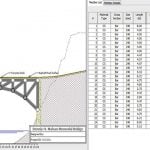FOR WATER TIGHT STRUCTURES
Crack width is a complex and tough topic. Most people still use 20 years old method defined in ACI 318-95. The situation becomes more complex if axial tension force and moment is combined to calculate crack width. One of the examples is large water tanks above ground. This tutorial aims at explaining details and methods in different ACI documents. Latest method defined in ACI 350-06 should be used. Given the variability and non-linear behaviour in long-term deflection and crack widths, it is NOT NEEDED to go for detailed sophisticated calculations for these effects. You can imagine this as calculating something non-linear (crack widths or long-term deflection) from linear-elastic analysis. You have to have some approximations for that. No matter how detailed are your calculations, you still can't predict for certain the long-term deflection and crack widths.
- Crack width is a complex and tough topic. Most people still use 20 years old method defined in ACI 318-95. The situation becomes more complex if axial tension force and moment is combined to calculate crack width.
- If the reinforcement spacing is set equal to the limiting values of Eqs. And in ACI 318-05, then the maximum flexural crack width can be controlled within the range from 0.40 to 0.50 mm. ACI 318-14 also uses the design equations that were recommended by ACI 318-05 for flexural crack width control.
- The flexural crack width expression in the above equation, with h-x d-x = 1.2, is used in ACI 318-95 in the following form: (8) z = f s d c A o 3 A maximum value of z = 3064.5 N/mm is permitted for interior exposure, corresponding to a limiting crack width of 0.41 mm. ACI 318-95 also limits the value of z to 2539.2 N/mm for exterior exposure.
Flexural Crack width Calculation for Rectangular RC Analysis & Design of Rc Beam as Per Aci 318-08 Isolated Foundation Calculation (ACI 318M-95) Base Plate Design Based on AISC-ASD 9th Edition Beam Connection Based on AISC-ASD 9th Edition Beam on Elastic Foundation Analysis Design for Bending Post at Top of Wall, Based on ACI 530-99 & UBC 97.
Three ACI documents for crack width; ACI 224R-01, ACI 350-01 & ACI 350-06
1. ACI 224R-01
Some notes:-
- Table 4.1 is based on Nawy findings.
- The table is just a general guide line.
- The table gives w=0.004″ or 0.10mm for water retaining structures.
- It is expected that portion of cracks will exceed these values by a significant amount.
- No relationship between level of cracking & corrosion in long-term.
- More cover can be used even if it yields larger crack width, against corrosion.
- ACI methods deal only with conventional concrete for crack width.
- Crack width is directly proportional to dia of bar & fs and inversely to area of steel.
- Three reasons for limiting crack widths
1-Appearance
2-Corrosion
3-Water tightness
There are three methods mentioned in this document
A) ACI 318-95
Statistical method of Gergely & Lutz 1968
Covers up to 2.5″ only
z in any units
For two-way slabs see section 4.3 of ACI 224R-01
For shallow beams/thick one-way slabs: (w in inches)
Thick means L/D = 15-20
d used here will be distance to the center of bottom bar nearest to tension face.
ß=1.25 to 1.35 if cc≥1″
ACI 318-95 section 10.6 says use ß=1.20 & fs=0.6fy
ACI 340R has design aids for z
ACI 318-98 & earlier max z=175 kip/in for interior exposure based on 0.41mm probable crack width(0.016″)
ACI 318 max z=145 kip/in for exterior exposure based on 0.33mm probable crack width(0.013″)
B) ACI 318-99
No distinction for interior/exterior exposure
For beams & one-way slabs:
fs=0.6fy
Not for aggressive/water tight structures
C) EUROPEAN CODES
—————————————————————————————————————————
2. ACI 350-01
Same concept like ACI 224R-01
—————————————————————————————————————————
3. ACI 350-06
2 types of exposure:-
i)Normal
ii)Severe
can be taken = 25
where c is at service load
ß can be taken = 1.20 for h≥16″
& 1.35 for h<16″
where appearance is of concern & cover exceeds 3″, also check equation 10-7
Exposure defined as
Previous codes (ACI 350-01) puts following limits on z:
Normal exposure: z=115 kip/in (w=0.010″ or 0.254mm)
Crack Width Calculation As Per Aci 318 14 Free
Severe exposure: z= 95 kip/in (w=0.009″ or 0.229mm)
—————————————————————————————————————————

EXAMPLE WITH AXIAL TENSILE LOAD AND MOMENT
- For detailed calculations, find the N.A. depth but use ԑ at service loads. Strain diagram will be different from the one shown in figure above if axial load is included.
- Assume no strength from concrete due to axial tension load.
- Assume tension force acting at steel reinforcement level.
- Assume all the moment is resisted by top and bottom steel only.
- Tension at top steel; T1 = A's / (A's+As+As1+As1) x Total Tension Force
- Tension at bottom steel;T2 = As / (A's+As+As1+As1) x Total Tension Force
- Tension at right steel; T3 = As1/ (A's+As+As1+As1) x Total Tension Force
- Tension at left steel; T4 = As1/ (A's+As+As1+As1 )x Total Tension Force
- Taking moment about top steel:
M=Asfs(d-d')+T2(d-d')+0.5T3(h/4)+0.5T4(h/4)
T3=T4 so
M=Asfs(d-d')+T2(d-d')+T3(h/4)
(where T is total axial tension force)
From here calculate fs and compare with fsmax of ACI 350-06.
JavaScript must be enabled in order to use this site.
Please enable JavaScript in your browser and refresh the page.
When beam design is done per ACI 318, STAAD will report the moment of inertia of the cracked section at the location where the design is performed. The cracked section properties are calculated in accordance with the equations shown below.
Rectangular Sections
Gross section (A) and cracked transform section (B) for rectangular shapes
Without compression steel
n = EI/Ec
Tee Shaped Sections
Gross and cracked transform sections for tee shapes without compression steel
Crack Width Calculation As Per Aci 318 14 Online
Without compression steel
See D1.F.4.5 Beam Design Output for an example of output including the calculated cracked moment of inertia.
